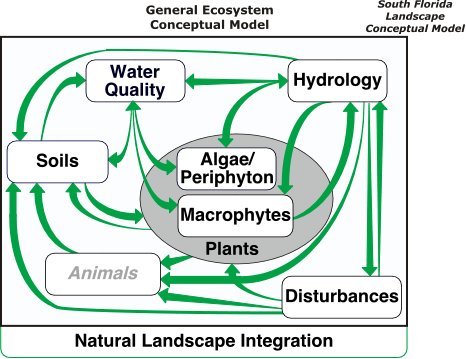![]() Background |
Models |
Projects |
Publications |
People |
News
Background |
Models |
Projects |
Publications |
People |
News
![]() Background |
Models |
Projects |
Publications |
People |
News
Background |
Models |
Projects |
Publications |
People |
News
Introduction
Wetlands & ecological models
Conceptual model: South Florida
Generic modeling framework

Hydrology is a critical "driver" of the landscape, in that we need to understand and get the water "right" in order to sustain a healthy Everglades.
Hydrology is one of the "fast" processes that can change significantly on time scales on the order of hours, but climate change can produce decadal shifts in dynamics of the regional hydrologic cycle. While rainfall in south Florida is seasonal, it is variable both within seasons and among years. Intense rainfall events are often heterogeneously distributed at local scales; tropical disturbances can deluge the entire region. The pattern of water distribution (hydropattern) across the landscape is driven not only by rainfall inputs and (atmospheric- and macrophyte- mediated) evapotranspiration losses, but is intensively managed via the operations of the water mangagement infrastructure (canals, levees, water control structures).
Changes to water depths and flows can alter the habitat because different macrophyte species and algal/periphyton assemblages have distinct hydrologic adaptations. Likewise, changing water depths can alter the soils through increased accretion rates when wet for prolonged periods (i.e., long hydroperiods). On the other hand, soil losses increase with the oxidation (and fires) occuring under short hydroperiods. This increased soil oxidation increases the nutrient availability surface/soil waters. Soil nutrient chemistry is also affected by water exchanges between surface and soil/sediment water storages, a vertical advective process driven by groundwater losses due to plant transpiration and/or horizontal groundwater flows.
Surface water flows are an important transport mechanism for nutrients and suspended organic matter in the landscape, while canal fluxes are faster across long distances. Surface water flows also play a role in suspension and deposition of soils & sediments, potentially altering the physical pattern of creeks and sloughs. While most of the horizontal flows in the Everglades are induced by head (elevation) gradients, wind and tide-driven circulation is predominant in Florida Bay. These surface flows are highly dependent upon the resistance to flow by macrophytes, and groundwater flows and seepage through levees vary significantly across the region depending on aquifer (or levee) transmissivity.
 EcoLandMod Background
EcoLandMod Background